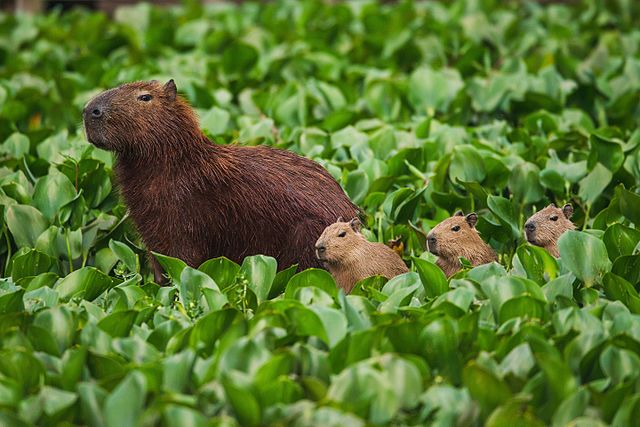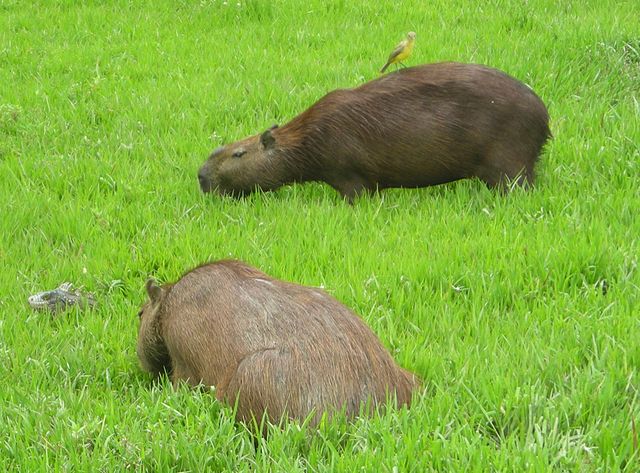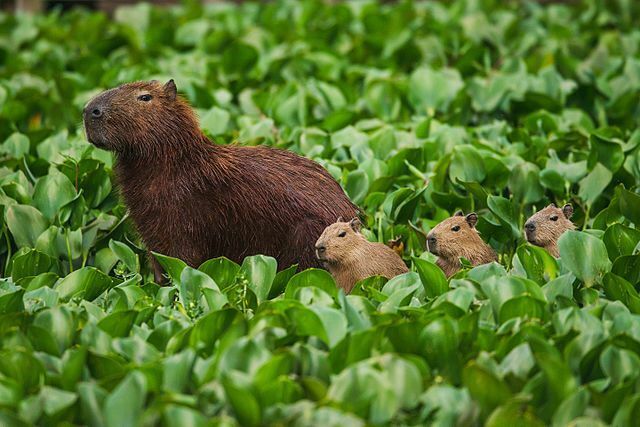
Origin, description, where it lives, its behavior, reproduction, predators, breeding and consumption
The capybara (Hydrochoerus hydrochaeris), also called carpincho, chigüiro, chigüire, ronsoco, or carpincho, and which can measure up to 1.3 m long and weigh up to 70 kg, is the largest rodent in the world.

Author: Taragui CCBY2.5
H. hydrochaeris has several different vernacular names, depending on the region they inhabit: capivara (Brazil), capybara (Peru, Ecuador), ronsoco (Peru), capihuagra (Ecuador), carpincho (Bolivia), chigüiro (Colombia), and chiguire (Venezuela).
Origen of the Hydrochoerus hydrochaeris
Hydrochoerus hydrochaeris is the only living representative of the Hydrochoeridae family.
Some classify it within the Caviidae group, where it is classified, within the rodents, in the cavioideus super family, together with other Amazonian rodents, such as agoutis (Dasyproctidae), pacas (Cuniculidae) and pacaranas (Dinomydae).
Their ancestors belonged to the Protohydrochoerus subfamily, which lived in the Pliocene. Later, it was in the subfamily of the Hydrokerines, to which the Hydrochoerus hydrochaeris is affiliated, appearing in the Upper Pliocene.
How did the capybara evolve?
The capybara evolved in America during the Cenozoic era, which dates from 65 million years ago to the present day.
The first modern rodents appeared 58 million years ago. In the Miocene epoch, Cenozoic era, evolution caused the divergence between the Eocardidae and the Hydrochaeridae, which were the ancient capybara.
The common ancestor was the Cardiatherinae, which was twice the size of today’s capybaras.
All the giant rodents that we find in the Amazon basin are native to the American continent.
The word hydrochoerus is derived from two Greek terms: hydro, water, and choiros, pig.
Description of the capybara
The capybara is an animal of the Cávidos family. It is the largest and heaviest rodent in the world. Its body is solid and rounded. Some say it is barrel-shaped. Its head is small.
The ears are small and round. The eyes are small. Their eyes, ears, and nostrils are arranged on the top of their heads, a feature common to partially amphibian animals.
It has twenty teeth. Its snout is blunt. It has four short legs, but the rear ones are slightly longer than the front ones. Íts feet are slightly webbed. It lacks a tail.
The capybara grows up to 1.30 m long and weighs up to 65 kg, with an average weight of 50 kg. The female is slightly larger than the male.
The fur of this species is thick and rough, although in some parts it is scarce. For that reason it is sometimes prone to heatstroke. To avoid this, and for the purpose of thermoregulation of the body, it covers itself in mud. The color of the fur is reddish brown on the upper part, and yellowish brown on the lower part of the body. The capybara’s skin is pink, and impervious to water.
Where does the capybara live?
The capybara is widely distributed throughout South America, particularly in the basins of the Orinoco, Amazon and La Plata rivers, from Venezuela to the north and center of Argentina. The only exception is Chile.
The capybara is a terrestrial animal, but it prefers to live near bodies of water, or in flooded areas.
It adapts very well to life in large plains and humid areas. It is often found in the extensive region of the plains of Venezuela, bathed by tributaries of the Orinoco River, and in the area of El Pantanal, in Brazil.
Capybara behavior
The capibara is an animal of twilight habits, with a great adaptive capacity, but it avoids the hours of greatest sun exposure. It rests in areas of dense vegetation. If there is a lot of human activity that compromises its safety, the capybara changes its behavior, developing nocturnal habits.
If it notices dangerous situations, the capybara alerts the others in its group by emitting short barks so that they can quickly escape. They run towards bodies of water, such as nearby rivers, to dive to safety.
They can stay up to 5 meters underwater, and swim quickly to evade the threat. They are excellent swimmers. They swim submerged in the water, except for their eyes, ears and nostrils.
The capybara is a gregarious animal. It generally lives in groups, ranging from six to twenty individuals; although in some cases their numbers may reach a hundred during the dry season, when in search of water. So, they are very vulnerable to predators, especially humans.

Autor: Fidel León Darder CCBY3.0
The capybara is a territorial animal. The males mark their territory with secretions from their scent glands, which are located near the nose, or in the region of the anus.
They communicate with their mates by vocalizations, such as a dog-like bark as an alarm signal, or purr to show submission, or may emit shrill growls and hisses.
What does the capybara eat?
They feed on wild terrestrial herbs and aquatic plants, but also crop grains, for which they are hated. They eat in moderation.
They consume between four and six species of plants during a certain period, but without exhausting them, stopping to facilitate their recovery. They are special coprophages.
They eat feces, as many rodents usually do, but only immediately after evacuation, as a way to reabsorb and make the most of available nutrients already eaten.
The lifespan of capybaras averages eight to ten years, although they can reach twelve years of life in captivity.
Predation, breeding and consumption
The natural predators of capybaras are felids, such as the jaguar, puma, ocelot, or jungle foxes, as well as alligators and anacondas. Their young can be preyed upon by birds of prey, such as the harpy eagle.
Specialists in this animal species point out that there are three basic requirements for the survival of the species. The first is to guarantee the availability of nearby aquatic environments. Water is very important for the capybara: for its reproduction, protection and the thermoregulation of its body.
The second is to guarantee the nearby availability of foraging areas. The third is to guarantee dry areas for the rest and shelter of the young.
The indigenous people hunt the capybara to consume its meat and use its skin. Some groups reject its meat because it seems to them to have a very unpleasant smell and because it is believed that its consumption produces stains on the body. From its fat they can extract an oil, which is considered medicinal.
Some indigenous groups also hunt them for their teeth, which they use as decorative elements.
It is common in the plains for large killings of capybaras during the dry season, when many individuals are concentrated. The capybaras are cruelly killed, clubbed or shot, indiscriminately. Or, hunting dogs may also be used to harass them to death.
Many indigenous people have capybara calves in their homes, which adapt very easily to domestic rearing.
The capybara in the indigenous worldview
Some indigenous groups respect the capybara. The Yanomami, indigenous people located in Brazil and Venezuela, believe that each person has a double that looks like a capybara or a tapir (Tapirus terrestrials), which provides them with their life force.
Is the hydrochoerus hydrochaeris in danger of extinction?
In nearby urban areas, and depending on the country, the meat or the skin is used, or both at the same time. Its meat is highly valued for consumption in some countries, especially during the Easter season on days of abstinence from meat, because capybara meat is allowed from the point of view of the Catholic religion.
This is the case in Venezuela and Colombia, countries in which the meat is previously dried, and then consumed pickled or fried as pisillo. In Argentina, Brazil and Uruguay, capybara meat is used to make sausages.
In Argentina, the skin is often used, as they are experts in the art of high-quality leather goods, and their leather processing technology is highly recognized internationally.
In Venezuela, Colombia and Brazil they make use of the meat, although the Brazilians are also experts in saddlery with capivara skin (they write it with a V in Portuguese).
Venezuela at one time had the best experience in semi-intensive, free-living farming, but the privately owned herds dedicated to this activity of conservation and ecological tourism, such as the El Frío herd, were invaded and looted.
The best captive breeding experience is mainly in Brazil and Argentina. Leather goods based on capybara leather are of high quality in Argentina, Colombia and Brazil.
Capybara Reproduction
Capybaras mate in shallow water. Intercourse is brief and can be repeated several times, with short pauses.
Mating occurs during any time of the year, but most births occur in the rainy season. Each female typically gives birth once a year, or on rare occasion, twice.

Author: Clodomiro Estévez Junior CCBY4.0
The gestation period lasts about 110 days. The females are multiparous, and have an average litter of four pups, but can range between two and eight per birth.
The young are very precocious, becoming independent from the mother three or four months after birth.
Bibliography
- Aldana-Dom{inguez J., Vieira-Muñoz M.I., Bejarano P. (2013). Conservation and use of the capibara and the lesser capybara in Colombia, 321-332. PDF En: Moreira J.R., Ferraz KMPMB., Herrera E.A., MacDonald D.M (eds). Capybara: biology, use and conservation o fan exceptional neotropical species. New York: Springer Book.
- AMARÚ. Capibara.Sitio web.
- Barreto, G. R., & Herrera, E. A. (1998). Foraging patterns of capybaras in a seasonally flooded savanna of Venezuela. Journal of Tropical Ecology, 14(1), 87-98. PDF
- Bolkovic M.L., Quintana R.D., Ramadori D., Elisetch M., Rabinovich J. (2006). Proyecto Carpincho. Propuesta para el uso sustentable del carpincho (Hydrochoerus hydrochaeris) en la Argentina. 94-120 PDF. En: Bolkovic M.L., Ramadori D. (eds). Manejo de Fauna Silvestre en Argentina. Programas de Uso Sustentable. Buenos Aires: Ministerio de la Salud y Ambiente de la Nación. Libro
- Giraldo-Hernández D., Ramírez-Perilla J. Guía para el manejo, cría y aprovechamiento sostenible del chigüiro, chiguire o Capibara Hydrochoerus hydrochaeris Linneo. Bogotá: Convenio Andrés Bello. Libro
- Herrera E.A. (1999). Comportamiento, conservación y manejo de fauna silvestre. El caso del capibara en Venezuela. Etología, 7, 41-46. PDF
- Mones A., Ojasti H. (1980). Hydrochoerus hydrochaeris. Mammal species (264), 1-7. Washington D.C. Society of Mammalogist.
- Moreira J.R., Pinheiro M.S. (2013). Capybara production in Brazil: captive breeding or sustainable management?, 33-344. En: Moreira J.R., Ferraz KMPMB., Herrera E.A., MacDonald D.M (eds). Capybara: biology, use and conservation o fan exceptional neotropical species. New York: Springer. eBook
- Moreira J.R., Alvarez M.R., Tarifa T. Pacheco V., Taber A. A. (2013). Taxonomy, natural history and distribution of the capybara. 3-37. PDF En: Moreira J.R., Ferraz KMPMB., Herrera E.A., MacDonald D.M (eds). Capybara: biology, use and conservation o fan exceptional neotropical species. New York: Springer.
- Smith M. (1981). Caimans, Capibara Otters manatees and man in Amazonia. Fuente Biological Conservation , 19 (3), 177-187.
- Wilson D.E. , Reeder D.N. (2005). Mammal species of the World. Baltimore: Johns Hopkins University Press.

Dr. Rafael Cartay is a Venezuelan economist, historian, and writer best known for his extensive work in gastronomy, and has received the National Nutrition Award, Gourmand World Cookbook Award, Best Kitchen Dictionary, and The Great Gold Fork. He began his research on the Amazon in 2014 and lived in Iquitos during 2015, where he wrote The Peruvian Amazon Table (2016), the Dictionary of Food and Cuisine of the Amazon Basin (2020), and the online portal delAmazonas.com, of which he is co-founder and main writer. Books by Rafael Cartay can be found on Amazon.com
This post is also available in:
![]() Español (Spanish)
Español (Spanish)
